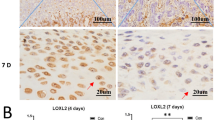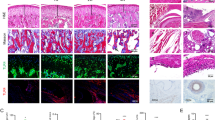Abstract
Local joint inflammation plays an important role in the pathogenesis of temporomandibular joint (TMJ) osteoarthrosis (TMJOA). Yohimbine, an alpha-2 adrenergic receptor antagonist, possesses anti-inflammatory properties; however, the ability of Yohimbine to protect against TMJOA-associated chondrocyte inflammation remains unclear. We conducted in vitro and in vivo analyses to investigate whether Yohimbine could ameliorate TMJOA-induced chondrocyte inflammation and to elucidate the mechanisms involved. Chondrocytes of TMJOA mice were stimulated with interleukin (IL)-1β or noradrenaline (NE), and the resulting production of inflammation-related factors was evaluated in the presence or absence of Yohimbine. Furthermore, two TMJOA mouse models were treated with Yohimbine and the therapeutic effect was quantified. NE (10−6 M) triggered inflammatory cytokine secretion by TMJ chondrocytes, and Yohimbine suppressed IL-1β- or NE-induced IL-6 upregulation in TMJ chondrocytes with the nuclear factor (NF)–κB pathway inhibition. Yohimbine also ameliorated cartilage destruction in the TMJOA models. Interestingly, αmpT, a tyrosine hydroxylase inhibitor, reversed the effects of Yohimbine by activating the NF-κB pathway. Collectively, these findings show that Yohimbine ameliorated TMJ chondrocyte inflammation and the suppression of NF-κB pathway contributes to this effect.





Similar content being viewed by others
Abbreviations
- ANOVA:
-
Analysis of variance
- AR:
-
Adrenergic receptor
- cAMP:
-
Cyclic adenosine monophosphate
- CBA:
-
Cytometric bead array
- CT:
-
Computed tomography
- DAB :
-
3,30-Diaminobenzidine
- DMEM:
-
Dulbecco’s modified Eagle medium
- DMSO:
-
Dimethyl sulfoxide
- HE:
-
Hematoxylin and eosin
- Ig:
-
Immunoglobulin
- IL:
-
Interleukin
- LPS:
-
Lipopolysaccharide
- MSC:
-
Mesenchymal stem cell
- NE:
-
Norepinephrine
- OA:
-
Osteoarthritis
- PBS:
-
Phosphate-buffered saline
- TH:
-
Tyrosine hydroxylase
- TMD:
-
Temporomandibular disease
- TMJ:
-
Temporomandibular joint
- TMJOA:
-
Temporomandibular joint osteoarthrosis
- TNF:
-
Tumor necrosis factor
- WB:
-
Western blot
- Yoh:
-
Yohimbine
References
Chantaracherd, P., et al. 2015. Temporomandibular joint disorders’ impact on pain, function, and disability. Journal of Dental Research 94 (3 Suppl): 79S–86S.
Barry, F., and M. Murphy. 2013. Mesenchymal stem cells in joint disease and repair. Nature Reviews Rheumatology 9 (10): 584–594.
Robinson, W.H., et al. 2016. Low-grade inflammation as a key mediator of the pathogenesis of osteoarthritis. Nature Reviews Rheumatology 12 (10): 580–592.
Neha, M.M. 2017. Ansari and H.A. Khan, Yohimbine hydrochloride ameliorates collagen type-II-induced arthritis targeting oxidative stress and inflammatory cytokines in Wistar rats. Environmental Toxicology 32 (2): 619–629.
Li, H., et al. 2012. Yohimbine enhances protection of berberine against LPS-induced mouse lethality through multiple mechanisms. PLoS One 7 (12): e52863.
Shimokawa, T., et al. 2020. Yohimbine ameliorates lipopolysaccharide-induced acute kidney injury in rats. European Journal of Pharmacology 871: 172917.
Jenei-Lanzl, Z., et al. 2015. Anti-inflammatory effects of cell-based therapy with tyrosine hydroxylase-positive catecholaminergic cells in experimental arthritis. Annals of the Rheumatic Diseases 74 (2): 444–451.
Capellino, S., et al. 2010. Catecholamine-producing cells in the synovial tissue during arthritis: modulation of sympathetic neurotransmitters as new therapeutic target. Annals of the Rheumatic Diseases 69 (10): 1853–1860.
Aurelian, L., et al. 2016. TLR4 signaling in VTA dopaminergic neurons regulates impulsivity through tyrosine hydroxylase modulation. Translational Psychiatry 6: e815.
Voisin, P., and M. Bernard. 2013. Cyclic AMP-dependent regulation of tyrosine hydroxylase mRNA and immunofluorescence levels in rat retinal precursor cells. Cell and Tissue Research 352 (2): 207–216.
Karkoulias, G., et al. 2007. Alpha2-adrenergic receptors activate cyclic AMP-response element-binding protein through arachidonic acid metabolism and protein kinase A in a subtype-specific manner. Journal of Neurochemistry 103 (3): 882–895.
Kindler, S., et al. 2012. Depressive and anxiety symptoms as risk factors for temporomandibular joint pain: a prospective cohort study in the general population. The Journal of Pain 13 (12): 1188–1197.
Calhoon, G.G., and K.M. Tye. 2015. Resolving the neural circuits of anxiety. Nature Neuroscience 18 (10): 1394–1404.
Lorenz, J., et al. 2016. Norepinephrine modulates osteoarthritic chondrocyte metabolism and inflammatory responses. Osteoarthritis and Cartilage 24 (2): 325–334.
Zhang, B., et al. 2020. Hyperactivation of sympathetic nerves drives depletion of melanocyte stem cells. Nature 577 (7792): 676–681.
Ou, F., et al. 2019. Temporomandibular joint disorders contribute to anxiety in BalB/C mice. Biochemical and Biophysical Research Communications 516 (2): 339–343.
Jiao, K., et al. 2016. Activation of alpha2A-adrenergic signal transduction in chondrocytes promotes degenerative remodelling of temporomandibular joint. Scientific Reports 6: 30085.
Lan, L., et al. 2017. Expression of Notch signaling pathway during osteoarthritis in the temporomandibular joint. Journal of Cranio-Maxillo-Facial Surgery 45 (8): 1338–1348.
Zhou, Y., et al. 2020. HMGB2 is associated with pressure loading in chondrocytes of temporomandibular joint: In vitro and in vivo study. Cytokine 126: 154875.
Wang, X.D., et al. 2012. Progression of cartilage degradation, bone resorption and pain in rat temporomandibular joint osteoarthritis induced by injection of iodoacetate. PLoS One 7 (9): e45036.
Xiao, D., et al. 2012. Protection of articular cartilage by intra-articular injection of NEL-like molecule 1 in temporomandibular joint osteoarthritis. The Journal of Craniofacial Surgery 23 (1): e55–e58.
Wadhwa, S., et al. 2005. Accelerated osteoarthritis in the temporomandibular joint of biglycan/fibromodulin double-deficient mice. Osteoarthritis and Cartilage 13 (9): 817–827.
Jenei-Lanzl, Z., et al. 2015. Proinflammatory receptor switch from Galphas to Galphai signaling by beta-arrestin-mediated PDE4 recruitment in mixed RA synovial cells. Brain, Behavior, and Immunity 50: 266–274.
El, B.K., et al. 2019. Norepinephrine inhibits synovial adipose stem cell chondrogenesis via alpha2a-adrenoceptor-mediated ERK1/2 activation. International Journal of Molecular Sciences 20 (13).
Grassel, S.G. 2014. The role of peripheral nerve fibers and their neurotransmitters in cartilage and bone physiology and pathophysiology. Arthritis Research & Therapy 16 (6): 485.
Sun, J.L., et al. 2020. Conditional deletion of Adrb2 in mesenchymal stem cells attenuates osteoarthritis-like defects in temporomandibular joint. Bone 133: 115229.
Tam, S.W., M. Worcel, and M. Wyllie. 2001. Yohimbine: a clinical review. Pharmacology & Therapeutics 91 (3): 215–243.
Paciaroni, N.G., et al. 2020. Yohimbine as a starting point to access diverse natural product-like agents with re-programmed activities against cancer-relevant GPCR targets. Bioorganic & Medicinal Chemistry 28 (14): 115546.
Funding
This work was supported by the Natural Science Foundation of Guangdong Province, China (Grant No: 2018A030313726) and the Science and Technology Planning Project of Guangdong Province, China (Grant No: 2015A030302019).
Author information
Authors and Affiliations
Contributions
Conceptualization, Farong Ou and Jiadong Sun; methodology, Yihuan Huang; software, Dongxiao Tang; validation, Dongxiao Tang; formal analysis, Rongsheng Zeng; investigation, Jiadong Sun; resources, Kai Su; data curation, Farong Ou; writing—original draft preparation, Farong Ou; writing—review and editing, Kai Su; visualization, Yihuan Huang and Dongxiao Tang; supervision, Guiqing Liao; project administration, Guiqing Liao; funding acquisition, Kai Su, Yiqing He. All authors have read and agreed to the published version of the manuscript.
Corresponding authors
Ethics declarations
Conflict of Interests
The authors declare that they have no conflict of interest.
Additional information
Publisher’s Note
Springer Nature remains neutral with regard to jurisdictional claims in published maps and institutional affiliations.
Rights and permissions
About this article
Cite this article
Ou, F., Huang, Y., Sun, J. et al. Yohimbine Ameliorates Temporomandibular Joint Chondrocyte Inflammation with Suppression of NF-κB Pathway. Inflammation 44, 80–90 (2021). https://doi.org/10.1007/s10753-020-01310-0
Published:
Issue Date:
DOI: https://doi.org/10.1007/s10753-020-01310-0




